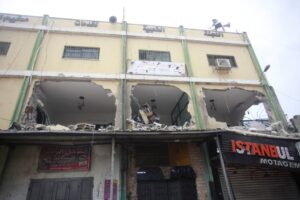Israel’s offensive in the West Bank is the second act of the Gaza genocide

Damage by Israeli troops as they withdrew from the al-Far’a refugee camp following a four-day campaign, near the West Bank city of Tubas, 12 February 2025.
Qassam Muaddi writes in Mondoweiss on 12 February 2025:
The Israeli army has expanded its ongoing military offensive in the northern West Bank from Jenin refugee camp to Nur Shams and al-Far’a refugee camps in Tulkarem and Tubas. The Israeli onslaught has led to the displacement of at least 40,000 Palestinians, according to UNRWA.
Scenes from Gaza are repeating themselves in the refugee camps of the northern West Bank as residents describe being kicked out of their homes by the Israeli army as soldiers go house to house, separating men, women, and children into different groups and marching them out of their neighborhoods at gunpoint. “It was very humiliating and painful,” one resident of Nur Shams refugee camp told Mondoweiss on Tuesday.
The three refugee camps and their surrounding cities have been at the center of a renewed wave of armed Palestinian resistance since 2021, especially in Jenin. In all three areas, Palestinian local resistance groups have been confronting Israeli raids with increasing efficiency and an accumulation of experience, albeit with very little means.
Israel has attempted to break the back of the rising phenomenon in the northern West Bank over the course of the last four years. In early 2022 it stepped up its campaigns of military reprisal with “Operation Break the Wave,” launching increasingly violent and disproportionate raids into Palestinian refugee camps. In July 2022, Israel reintroduced airstrikes in the West Bank to target Palestinian fighters in Jenin, before expanding the use of airstrikes to other parts of the West Bank’s north.
Following October 7, 2023, Israel escalated its raids to another level, taking advantage of the post-October 7 furor to change its military strategy in the West Bank. According to Israeli officials, the current offensive, dubbed “Operation Iron Wall,” aims to “change the security status quo” in the West Bank by definitively crushing the armed resistance, suggesting that its primary goal is security-driven. But the real reason for the wide-ranging escalation in the West Bank surpasses any pretenses of maintaining “security.”
Beyond ‘security’
Skyrocketing Israeli violence after October 7 was often unaccompanied by a security explanation, and much of it was not directed against armed groups. Israel imposed hundreds of additional checkpoints across the West Bank and arrested up to 5,000 Palestinians, including over 3,600 under administrative detention — that is, without charge or trial. It escalated home demolitions in ِArea C (which makes up over 60 percent of the West Bank) and distributed firearms to settlers who forcibly displaced up to 20 Palestinian rural communities in the West Bank. Most of these communities were located in areas that haven’t witnessed any armed Palestinian activity for years, like in the South Hebron Hills and in the eastern slopes of the central Jordan Valley.
**** ****
When another representative of the hardline religious right, Itamar Ben-Gvir, resigned from his post as National Security Minister in opposition to the current ceasefire deal, Smotrich did not leave Netanyahu’s cabinet, despite voting against the ceasefire. Analysts have described the “Iron Wall” offensive in the West Bank as Netanyahu’s concession to Smotrich in exchange for refraining from resigning, which would have jeopardized Netanyahu’s cabinet and forced him to call for new elections.
